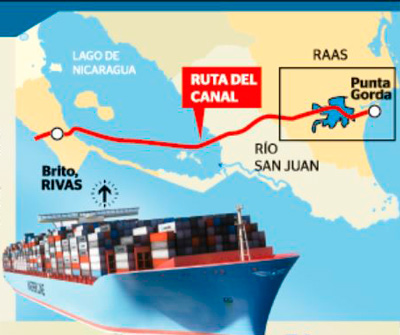Chinese Consortium and Nicaragua Say Canal Project Begins in December

HAVANA TIMES — The Chinese consortium HKND and the Nicaraguan government declared on Thursday that, by the end of next month, they will be ready to begin the construction of an inter-oceanic canal that will connect the Caribbean Sea and Pacific Ocean, at a cost of 50 billion dollars, DPA reported.
This was the announcement made by HKND representatives and authorities from the Great Canal Commission (“Comision del Gran Canal”) when they publicly divulged the details of the mega-project, which included engineering, environmental impact, economic and social reports, during a meeting that lasted more than ten hours.
HKND general sub-director for construction Kwok Wai Pang announced that the project will begin with perimeter structures such as roads and ports, needed to receive and transport machinery and equipment to be brought to Nicaragua from China and other countries.
Kwok said that the route chosen for the inter-oceanic canal was slightly modified in order to preserve the swamp areas in the south Pacific zone. As a result of this, the Brito port will not be built on the coast but will become an “inland port.”
Zhu Xioaya, representative of HKND’s President Wang Jing, stressed that the Chinese company is “committed to the principles of legality, transparency and justice” and that field studies have been conducted “in a scientific and rigorous manner.”
Zhu dismissed criticisms leveled at different parts of the project and stated “the canal will be a great success” and “will improve the standard of living of millions of Nicaraguans.” In addition, the canal is to be built as per the highest professional standards and in compliance of international norms.
In 2013, President Daniel Ortega granted Wang Jing a concession to build and manage the megaproject for a period of up to 100 years, a decision which was criticized by different sectors within the country.
The executive secretary of the Great Canal Commission, US citizen Paul Oquist, said that the construction of the canal will begin on December 22. However, the official canal spokesperson, Telemaco Talavera, told journalists construction would actually begin on the 24th of the month.
Oquist, who also serves as Ortega’s advisor, stated that the government “will always be in control of the project’s progress,” apparently alluding to the critiques voiced by environmental leaders who fear the canal will cause irreversible ecological damage in Nicaragua.
He said the canal will cost anywhere from 40 to 50 billion dollars and will generate 50 thousand jobs during the construction phase, in addition to 200 thousand indirect jobs in areas such as infrastructure, transportation, restaurants and hotels.
He added that they are planning to hire local workers to build a town or human settlement where some 140 thousand people involved in the construction of the canal will live.
Among other news, it was announced that the megaproject involves the construction of an artificial lake, to be named Atlanta, in the south Caribbean region, and that a new international airport will be built in the southern province of Rivas.
Other components of the canal will include free trade zones, tourist complexes and a wide range of factories, as well as a maritime port in the south Caribbean region known as Punta Gorda.
The inter-oceanic passage will be a 278-kilometer-long canal, 105 kilometers of which will cross the Lake of Nicaragua, splitting the country in two.
Thomas Koen, from the Belgian company SBE, reported that two 525-meter-long, 80-meter-wide and 25-meter-deep floodgates and storage pools for lake water – the largest in the Americas, measuring 8 thousand kilometers squared – will also be built.
Spokesman Talavera stressed that no explosives will be used for the dredging of the Lake of Nicaragua, and that an “environmentally friendly” technique involving the extraction of sediments would instead be employed. He maintained that the indigenous populations that inhabit the Indio Maiz reserve in southern Nicaragua would not be affected.
“We are going to protect the reserve and build the canal with the least degree of environmental impact and the greatest possible social and economic impact. This is going to be an environmentally friendly canal,” he underscored.

As Paul Oquist as advisor to Ortega says tthat the canal project will generate quarter of a million jobs with construction, infrastructure, transportation etc during the construction phase, it would be interesting to know the equivalent figures for employment during the construction of the Suez and Panama canals?
The indicated lapse of two days in commencing construction is peculiar.